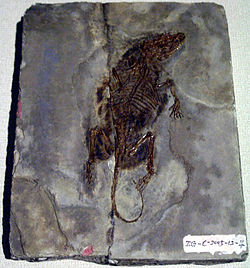| Trechnotheria Temporal range: | |
|---|---|
 | |
| Fossil of Zhangheotherium , a "symmetrodont" | |
 | |
| Red fox, a modern-day trechnotherian | |
| Scientific classification | |
| Kingdom: | Animalia |
| Phylum: | Chordata |
| Class: | Mammalia |
| Clade: | Theriiformes |
| Clade: | Trechnotheria McKenna, 1975 |
| Subgroups [1] | |
| |
Trechnotheria is a group of mammals that includes the therians and some fossil mammals from the Mesozoic Era. It includes both the extinct symmetrodonts and the living Cladotheria.
Contents
Trechnotheria has been assigned various ranks, but was originally described as a "superlegion" by the naming authority. [2] A later node-based definition for Trechnotheria was the clade comprising the last common ancestor of Zhangheotherium and living therian mammals, and all its descendants. [3] Alternatively it can be defined as the group with true symmetrodontia, being defined as an apomorphy rather than being defined as a node, the redefinition includes the Tinodontids. [4]







